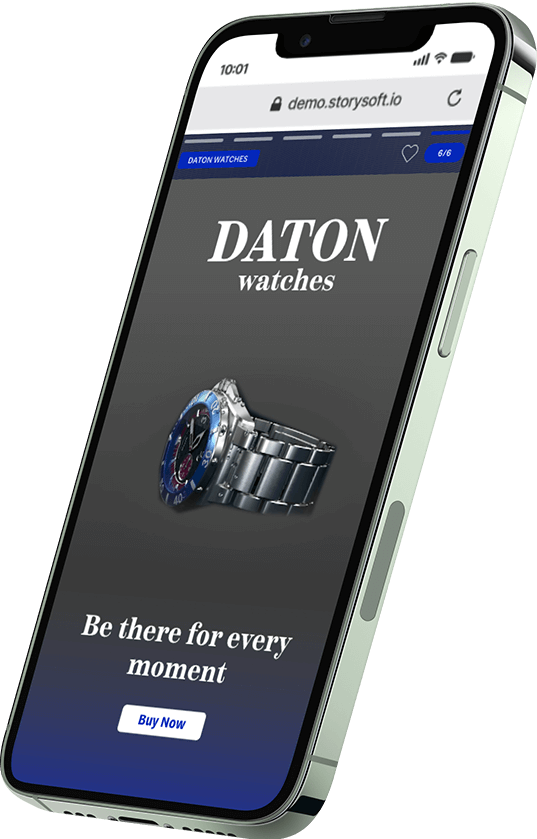How to Use Brand Storytelling to Break Through: The Ultimate Guide
Infusing brand storytelling into your marketing strategy will help your brand stand out, take you to the next level, and leave your competition scrambling to figure out what the heck just happened.
In today's guide you'll learn:
- The secret to why stories sell
- How to structure your brand stories for success
- How to use brand storytelling to cut through the clutter
- Why storytelling is important in a digital world
In short, if you want to break through, capture attention, build loyalty, and drive sales for your brand, buckle up because this guide is going to give you that, and much more.
Contents

Chapter 1
Brand Storytelling Basics

Chapter 2
The Power of Brand Storytelling

Chapter 3
Structure Your Brand Story for Success

Chapter 5
Telling a Brand Story in a Digital World

Chapter 6
Conclusion
CHAPTER 1:
Brand Storytelling Basics
In this chapter we will review the fundamentals of brand storytelling, including why brand storytelling is so important.
It's critical to begin with a strong brand storytelling foundation.
So if you're new to storytelling as a marketing concept, this chapter is for you.
Let's get after it.

What Is Brand Storytelling?
Brand storytelling is the act of using an emotion-evoking narrative to connect your brand to customers, with a focus on creating empathy by aligning your brand values with your customers' values.
The key to telling powerful brand stories is developing an emotional resonance with your audience.
A brand story is not just a series of events (and then, and then, and then), it's a journey of suspense during which the audience feels the experience.
The most powerful brand stories cultivate empathy, capture and hold an audience's attention, and compel them to take an action which directly benefits both the customer and the brand.

A Brief History of Storytelling
Storytelling is ancient.
People were telling each other stories to describe things they saw and explain experiences they had prior to written language. That form of storytelling is called oral tradition.
Storytelling is fundamental to how we, as humans, consume and relay information.
If you think about it, storytelling is fundamental to marketing as well. Marketers have been telling stories from the very beginning. The only thing that's changed along the way is the mediums we use to share our stories.
Powerful Examples of Brand Storytelling in Advertising
IVORY SOAP
A great example of brand storytelling in advertising is Ivory Soap, which used the tagline: It Floats!
Ivory Soap employed visual storytelling to convey the convenience of buoyant soap. Each consumer would imagine their own struggles of losing their soap to the bottom of the bathtub when seeing the Ivory Soap ad. They became the story.
Its beauty was in its simplicity. A simple image with a single message.
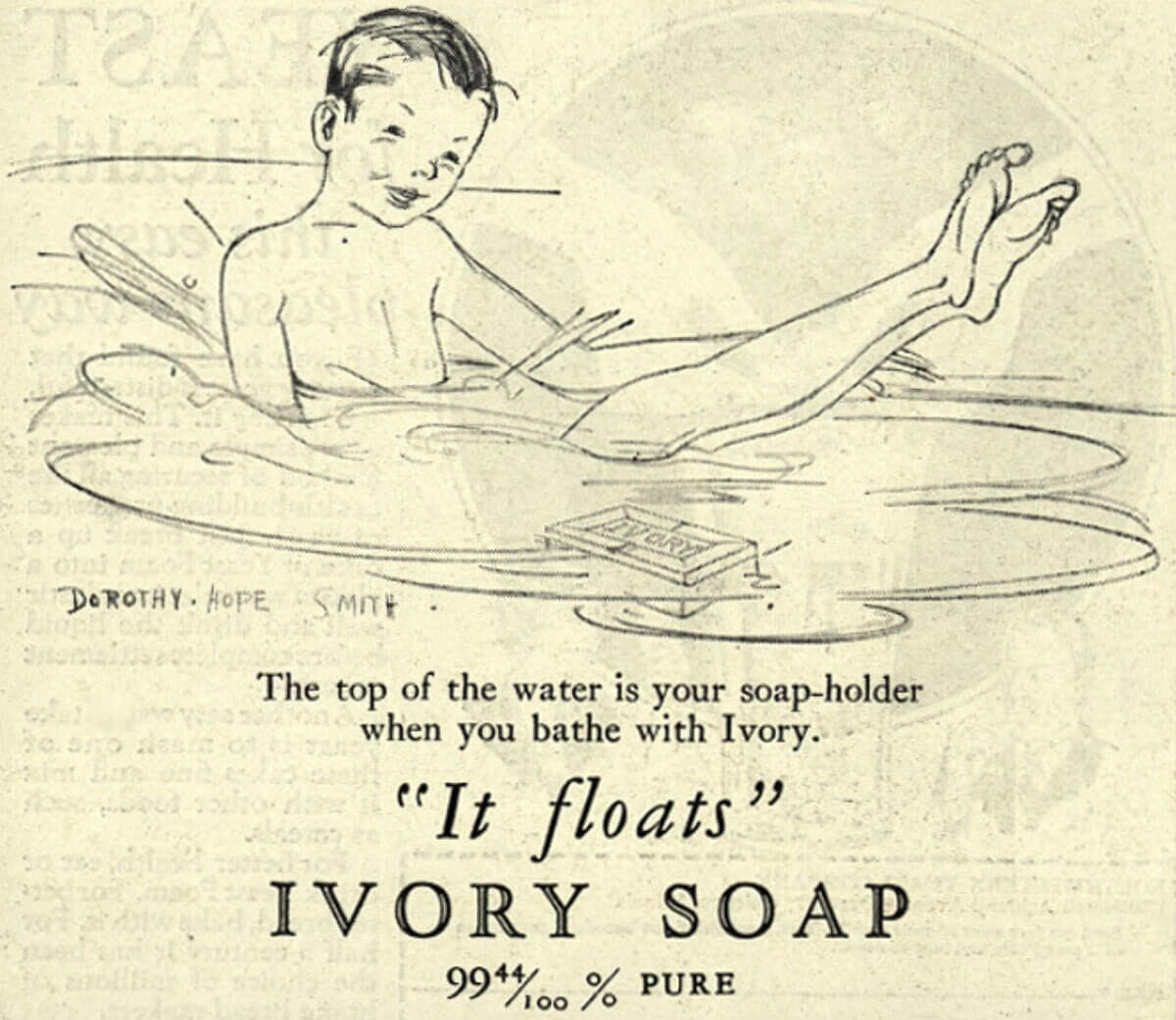
Marketers behind the Ivory Soap ad tapped into the challenge other soap products presented and then provided Ivory Soap as the solution: a soap that floats.
APPLE COMPUTER
Apple is another company that understands the power of storytelling in marketing.
Apple is all about thinking differently, fighting back against conformity, and expressing originality. It wants to tell a story that strikes a chord with people who share the same values.
Back in the 80s, Apple used TV and print ads to tell its stories. One of Apple's most famous commercials, "1984," premiered during Super Bowl XVIII to help sell the new Macintosh computer.
In that spot, Apple told a powerful story about fighting back against Big Brother (IBM).
The commercial showed hundreds of men listening to Big Brother deliver a speech about censorship. Halfway through the speech, a model ran into the room and threw a baseball bat at the screen, destroying it, and freeing the men from Big Brother’s grasp.
In a few short seconds, Apple was able to tell a story that evoked powerful emotions within its audience. People wanted to stand proudly next to a brand that wasn't afraid to speak out, to think differently.
Sales of the Mac soared after the release of "1984," arguably the Super Bowl's greatest commercial to date.
Why Now for Brand Storytelling?
Now, more than ever, you must tell your brand story if you want to succeed in the global marketplace.
TV is out. The new battle of the brands is being fought on the internet. And the competition is FIERCE.
The internet has made it cheaper and easier than ever before to reach your audience. The problem is that you're now competing with tens of thousands of brands, small and large, for your customers' attention.
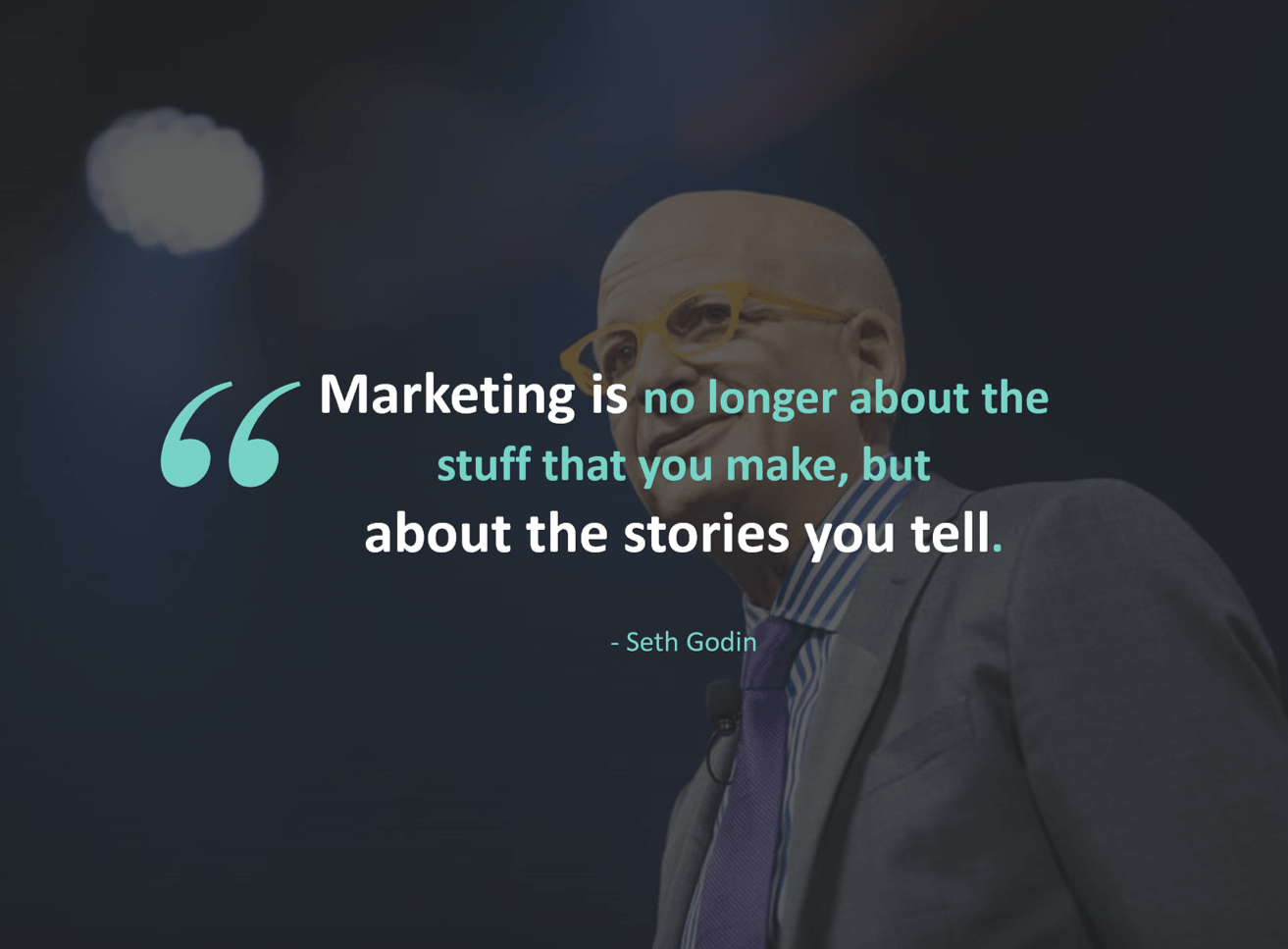
In an age of distraction and unlimited choice, brands need to find a way to break through to consumers, create loyalty, and drive sales.
Storytelling is it.
CHAPTER 2:
The Power of Brand Storytelling
This chapter is all about connecting the dots to what makes brand storytelling such a powerful content marketing strategy.
Understanding the power of storytelling will ultimately help you create remarkable brand stories that move people. It will also give you confidence needed to justify the approach to senior leadership, ensuring them that it will work.
Pumped for the power of brand storytelling? If so, let's get started.

Why Tell Stories?
Two words: Break through.
We are all inundated with marketing messages on a daily basis. When you consider the following stats, it's safe to say that marketing saturation is taking place. (And by the time you read this, these stats will already be outdated. That's how quickly things are moving.)
- Every 60 seconds, 3,780,000 Google searches are performed
- 4.4 million blogs are published daily (Source: Worldometers)
- 5.3 trillion ads are shown online each year
- The average consumer processes 100,500 digital words daily
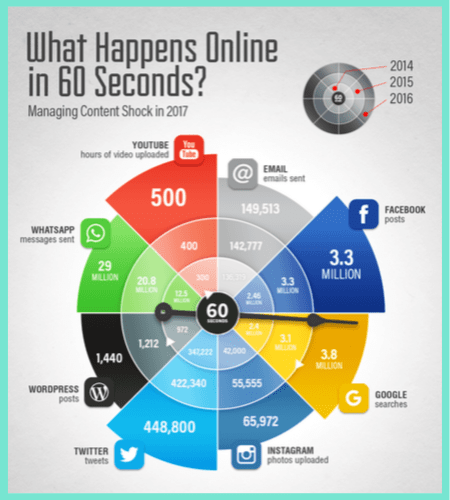
The result of this saturation? Consumers are ignoring our marketing messages.
Marketers shouldn't take it personally. With so much information thrown at them, consumers are in survival mode.
They are turning to tools like ad-blocking software just to get a respite.
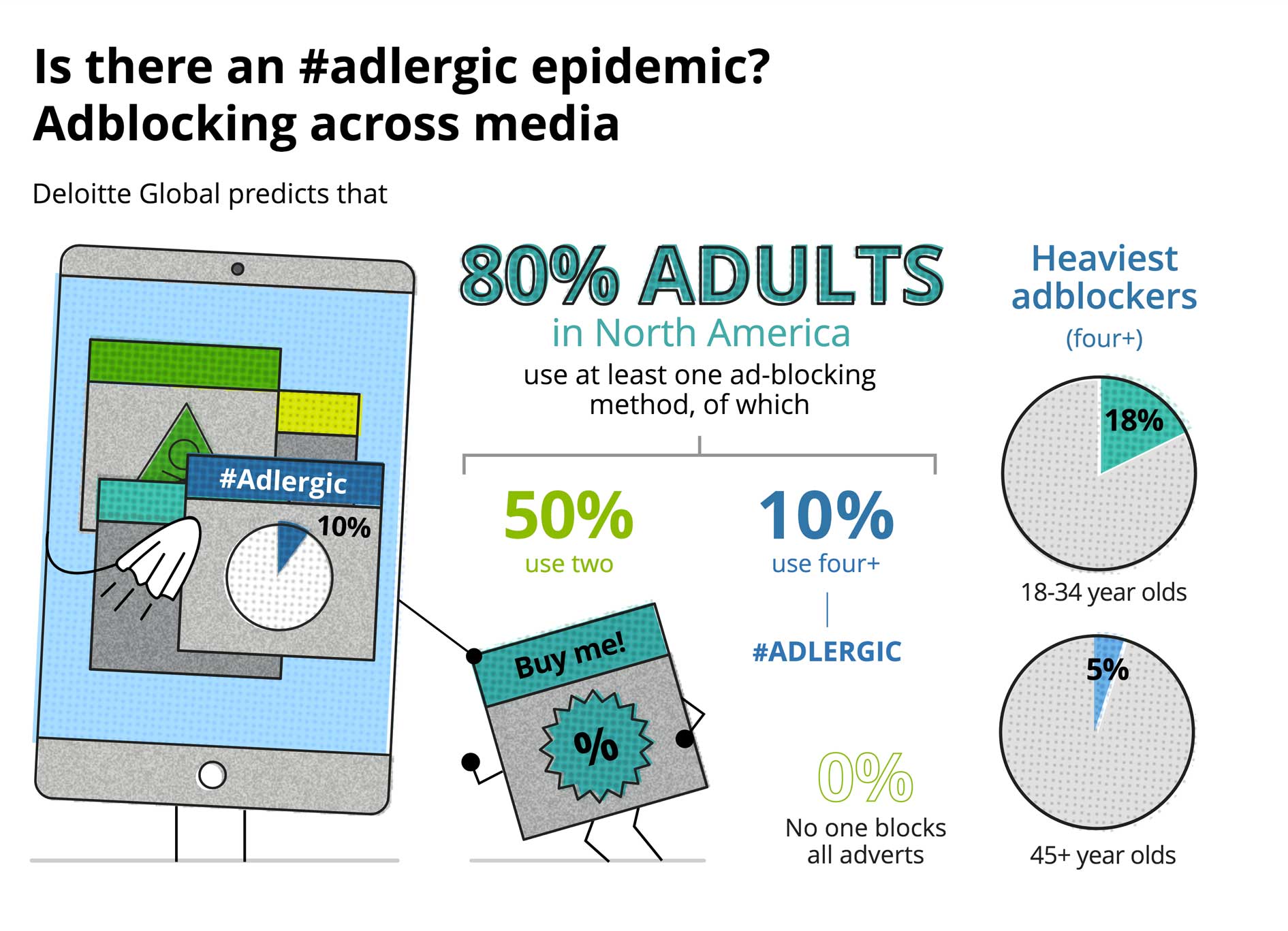
How can you get your brand to rise and cut through the clutter?
Inject storytelling into your content marketing strategy.
Why?
Because stories break through.
What Makes Brand Storytelling So Powerful?
It's simple. Empathy.
Great stories create a empathetic bond between the main character and the audience. The "they're just like me" feeling that audiences experience when consuming stories causes an emotional resonance that deepens engagement.
Stories hang off that cultivated empathy within audiences. Empathy is what allows the audience to place themselves in the story, putting themselves in the shoes of the main character.
When the main character encounters a seemingly insurmountable obstacle, the audience experiences their sadness, fear, guilt, etc. Similarly, if the main character overcomes that obstacle, the audience feels as if they've overcome that same obstacle. They mirror the main character's feelings of joy, satisfaction, love, and so on.
Empathy forges an emotional connection between a brand story and its audience, getting them invested in your brand so that they're compelled to make brand-friendly decisions.
Humans Are Hardwired for Stories
The human mind is a biological engine built by evolution to constantly create and consume stories.
Stories affect us physically and mentally. In studies of the brain, researchers have seen that the same areas of the brain light up when we are experiencing something and when we are watching a character experience it.
To our mind, there is no difference between reality and story.
This is incredibly significant for marketers. It means that we can use storytelling to create experiences for consumers that are just as impactful as if they were participating in a real-life event.
During moments of intense conflict in a story, chemical reactions take place within the brain, like the release of oxytocin and dopamine, flooding our senses.
According to Marsha Rossiter's 2002 paper, Narrative and Stories in Adult Teaching and Learning, stories are effective educational tools because they engage audiences to the point that story messages are better remembered.
Storytelling is a foundation for learning and teaching. While the listener is engaged, they are able to imagine new perspectives in what is a transformative and empathetic experience.
The fact that stories help humans remember important messages can be substantiated by the work of cognitive psychologist Jerome Bruner. He states that messages delivered as stories can be up to 22x more memorable.
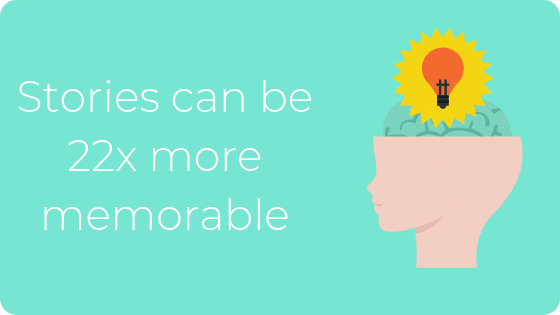
Storytelling is at the core of great marketing.
Without storytelling, marketing messages simply fall away into a sea of similar rhetoric.
If you believe Dr. Bruner, injecting your marketing messages into brand stories gives you the best chance of successfully achieving your marketing goals.
Story Marketing Captures Audience Attention
In a world of distraction, being attention-grabbing is a marketer’s most valuable asset. Storytelling captures an audience’s attention and holds it in suspense until the story is finished.
Having created that aforementioned emotional connection with your audience, they stay locked in through every twist and turn of the brand stories you tell.
Think back to watching some of your favorite movies. Were you captivated, eyes glued to the screen? When you checked your phone at the end of the movie, were you surprised by how much time had passed?
Well-crafted stories do more than draw us in, they maintain our attention by taking us on an emotional roller coaster ride. This sustained attention ensures that all of your key marketing messages get consumed and cataloged in their minds.
A Powerful Brand Story Compels Action
In their book, Storynomics, Robert McKee and Thomas Gerace discuss the "open-mind moment" concept.
The open-mind moment occurs during the story's climax. It jolts the audience's mind with a rush of emotional insight, a flash of understanding when the meaning of the story is revealed.
The mind is opened.
Neuroscientists have measured this open-mind phenomenon and found that it lasts approximately six to eight seconds.
In this moment of wonder and pleasure, anything presented to the mind lodges in its memory. This is the optimal spot for marketers to plant their logo or call-to-action.
Only when people are open to receiving your sales messages will they take action to buy your product or service.
CHAPTER 3:
Structure Your Brand Story for Success
During this chapter, we are going to dig into the common structure that all great narratives share.
Implementing the right story structure is critical to telling effective stories. Because of its importance, this section is a little heavier in terms of content.
We need to go deep into the components of effective storytelling so that you don't end up with a flat narrative of "and then and then and then."
Grab some water, and let's jump in.

What Are the Components of a Great Story?
When digging deep into storytelling, you begin to notice that the best stories share a similar structure.
Breakthrough stories have a formula.
The best part?
That formula can be learned.
All stories have a beginning, middle, and an end. For marketing purposes, think of these phases of story as: introduction, challenge, solution.
Let's break each one down.
Story Introduction
The beginning of a story introduces the setting, the story's theme, main character, and so on. The core message (plot) starts to unfold, along with what motivates the main character to make certain decisions.
For your marketing stories, it's important that you choose to center your story around the values shared by your target audience.

Think back to the Apple example. Their brand stands for going against the status quo.
In Apple's "1984" commercial, they pulled that core value through, their story resonating with like-minded consumers.
The only way to know for sure if your story will hit the mark is to truly know your customers. Market research is vital.
From there, you must find out what problems your audience has. Then show how they can be solved with your product or service.
If you craft your story around a challenge that resonates with the audience, it'll create what's called a "mirror experience."
The Mirror Experience
The mirror experience occurs when the audience can put themselves in the shoes of the main character.
An audience will replace the main character with themselves. It's that empathetic "like me" feeling that you read about above.
Facilitating a mirror experience with your brand stories is the secret to why storytelling is the best approach to driving the consumer behaviors you seek.
According to Robert McKee and Thomas Grace, the emotional mirror experience begins and ends with empathy.
When a protagonist radiates a positive human experience, this center of good attracts the audience's natural instinct to connect with a fellow human being. The audience falls into a subconscious identification, aka empathy with the main character.

3 Steps to Creating the Emotional Mirror Experience with Brand Storytelling
- Identification - The moment the target consumer (audience) recognizes the shared values between themself and the main character.
- Subconscious Switch - Once identification occurs, the audience feels this is "their" story and replaces the main character's desire for their real-life desire. This means that, subconsciously, when they're rooting for your story's main character, they're actually rooting for themself.
- Reenactment - The audience member's mirrored experience motivates them to act. Wishing to relive the positive feeling of the story, [they] purchase the product or hire the service that was set up as the solution.
The Story Challenge
Since you used market research to identify a specific challenge that your audience has, you know what challenge to inject into your story.
An inciting incident is a moment when a shift occurs, usually a negative event, throwing the main character's life out of balance.
This sudden reversal of fortune in the main character's life mirrors the customer's life and reflects their target need, that being the unsatisfied desire that you discovered during your research.
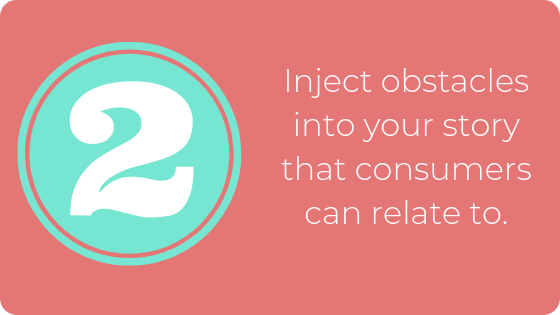
An inciting incident sends the main character on a journey to discover a solution and overcome the challenge, restoring balance back to their life.
Pepper this section of the story with obstacles to create suspense and hold the audience’s attention as they join the main character on their emotionally charged journey.
The Emotional Journey
Because of the emotional mirror experience, the audience will feel as if they are encountering every obstacle the main character is encountering, thinking about how they would handle them in their own lives.
It's this insertion of the self into the story that forges such a strong connection between the teller (brand) and the audience.
With longer stories like movies or novels, it takes repeated steps for the main character to overcome their challenge(s).
Marketing stories are usually shorter. More times than not, there is a single challenge with a single solution.
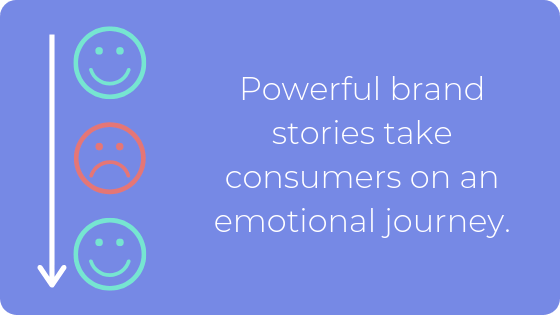
As you read earlier, chemicals are released during this emotional journey, helping the audience remember your story and your marketing messages.
Whether your marketing story is short or long, the solution is ALWAYS your product, service, brand, or company.
The Story Solution
At the end of the story, the main character uses your solution (product, service, etc.) to solve their challenge and restore balance back to their life.
The story comes together for the audience. They connect the dots, the story's meaning revealed in an AHA moment.
During those precious 6-8 seconds (that open-mind moment window), marketers can plant their call-to-action. The CTA should align with the solution that the audience just experienced the main character use to solve their challenge.

Wanting to solve their problem and relive the emotional high they felt when the main character solved their similar problem, the audience will follow your CTA and go buy your product or service.
The best part? Because of the emotional journey you brought the audience on, and the chemical reactions that took place in their brains, those positive associations with your brand will remain.
The next time the audience faces the same challenge, they will automatically reach for your product or service AGAIN. Every. Single. Time.
Marketing stories about your brand, product, or service act like a magnet. Create the right connection and it will last forever, constantly attracting your audience to your products and services.
CHAPTER 4:
How to Get Started with Brand Storytelling
In this chapter, you will learn everything you need to know about getting started with telling brand stories.
A lot of what we cover will feel familiar to you. Remember, as marketers, we tell stories all the time.
Now we are simply being more purposeful about telling stories and building emotional bonds.
If you're ready, let's begin.

Where Should I Start With Brand Storytelling?
When it comes to storytelling marketing, start with a plan. Sounds familiar, right? Storytelling works similarly to other marketing strategies.
You must know where you're going, why you're going there, and how to measure your success.
Follow these steps to get started with storytelling for your brand:
- Set your storytelling goals and objectives
- Determine what type of story you want to tell (i.e. brand story, product story, customer story, etc.)
- Conduct market research (or dig into your existing customer research) to identify your target audience's key challenges (remember to align these with the challenges your product solves)
- Identify the marketing channels you want to use for telling your story (these should be channels where you can reach your target audience)
- Set key performance indicators which will allow you to determine if you are meeting your goals
- Pull together a storytelling team to help you execute
What Team Members Do I Recruit for Creating a Brand Story?
Like all great marketing campaigns, when it comes to telling powerful marketing stories, it takes a village. Recruiting the right team members is crucial.
Build your storytelling team with these roles:
- Writer
- Art director
- Digital director
- Marketer (possibly you)
- Project manager
In every organization these roles might look a little different or be referred to by other terms, but the essence remains the same.
You need someone to write the story, someone to bring it to life creatively, someone who knows how to use digital to distribute it, a marketer to oversee the program, and a project manager to keep everyone on track.
The Difference Between Content Marketing and Storytelling Marketing
Once you bring your team together, the first thing to do is get them in a room and explain how storytelling is different than content marketing and educate them on what makes storytelling so powerful.
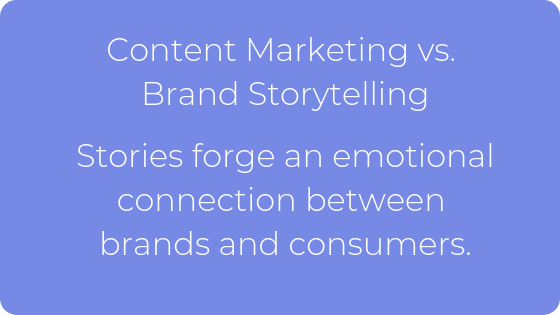
*Hint: Traditional content marketing usually focuses on the "what." What your product does, what features you offer, what it looks like, etc.
Storytelling is all about the "hows" and the "whys." The "hows" and the "whys" are where the emotional aspects of your brand, product, and service stories lie.
- How can our product solve your challenge?
- Why did we start this company?
- Why does customer Jane love our product?
It's critical that your team knows that storytelling is much more than a series of "and then, and then, and then."
You can always have them read this brand storytelling guide for more information.
Brand Story Checklist
When you and your team begin constructing your brand story, make sure you account for each one of the following components.
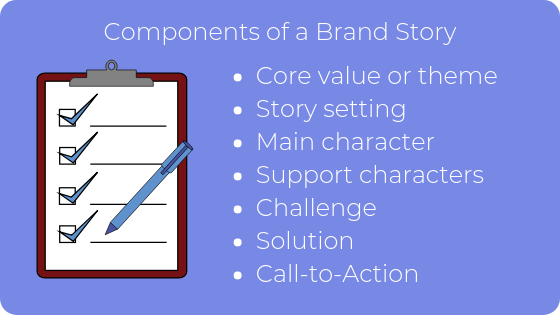
Core value or theme
A story's core value is a quality that both your brand and your audience exude. You want to tap into it. Remember Apple's "1984."
Story setting
For your brand story, choose a location in space and time for your story's events to unfold.
Main character
Develop a main character that your audience can relate to. Usually main characters are people who represent your customer, your brand, or your product.
A good example of a main character who represents a product once again comes from Apple. Their Mac vs. PC commercials use two people, one who represents a Macbook and another who represents a PC.
Supporting characters
You may or may not need a supporting cast for your story. These could be people your character leans on for support/advice or someone who is creating the chaos that your main character is challenged by.
Challenge
Through your market research, you have identified one or more challenges that your target audience faces. Pick one to focus on, then craft a series of events that bring that challenge to life.
Obstacles create that emotional roller coaster for the audience, holding their attention while they wait to see how the story will turn out.
Solution
Determine how you will present your product, service, or brand as the hero of your story, meaning the solution to the main character's main challenge.
Call-to-Action
During that open-mind moment, place a call-to-action that will compel the audience to turn to your brand, product, or service for a solution to their own problems.
A strong CTA will help you achieve your story objectives.
What Marketing Channels Work Best for Storytelling?
After bringing your brand story to life, it's time to share it with the world.
Determine which marketing channel(s) you want to deliver your brand story through.
While there is still a place for print marketing, our world has gone digital (and to be more exact, mobile).
Digital provides marketers with countless benefits, so it only makes sense to use digital channels for your brand stories.
Digital storytelling can be executed using:
- Your website
- Social media
- Email newsletters
- Podcasts
- Even digital ads
I recommend using all of your digital channels to tell your brand story. The challenge is that each of these channels has a specific set of configuration requirements.
You don't want to create your story multiple times so that it only works within the confines of each channel. You want to build your story once and distribute it everywhere.
CHAPTER 5:
Telling a Brand Story in a Digital World
If you've made it this far, you're on track to becoming a brand storytelling expert, storytelling best practices tucked away in your mind for safekeeping.
In this penultimate chapter, we are going to talk about the STORYSOFT platform.
Yes, it's a bit self-promotional, but we think you'll find it valuable. We believe our platform provides marketers with the best tool for telling brand stories in today's digital world.
Stay with me to learn more about how our digital storytelling solution can help you tell breakthrough brand stories.

How Can My Brand Cut Through the Clutter?
How many promotional emails did you wake up to this morning? What's the number of Instagram ads you have scrolled through so far? How many search results were displayed when you asked Google a simple question?
It's overwhelming, isn't it?
So, what did you do?
You ignored 99.9% of those ads and content, right?
In our digital world, reach has been commoditized.
It doesn't matter if you're the biggest brand on the planet or a one-woman band selling t-shirts, you can reach your customers at a scale like never before for the cost of meal at Panera.
It's the most incredible time to be a marketer.
But just because you can reach your customers doesn't mean you'll grab their attention.
The question you should be asking is, how can I capture AND KEEP my audience's attention?
The answer?
Tell powerful, emotion-evoking, make-consumers-cry-for-your-brand, laugh-for-your-brand, love-your-brand stories.
STORYSOFT Stories
As a team of marketers and technologists, we struggled with the same content marketing problem.
We needed to create marketing campaigns that broke through the marketing clutter, captured attention, built loyalty, and drove sales.

In realizing that storytelling was the solution and the next big thing in marketing, we made it our mission to help brands tell breakthrough stories.
But we quickly hit a roadblock.
We found out that a single story had to be told ten different ways in order to fit the restrictions of each platform we wanted to use to get the story in front of our audience.
A keyword filled diatribe for the blog.
280 characters or less for Twitter.
Images only for Instagram.
We needed to find a way to create stories once, share them through every channel, and allow them to live forever online.
So, we created STORYSOFT.
Why Use STORYSOFT?
STORYSOFT is the ultimate digital storytelling platform.
The platform combines a proven storytelling framework, integrated marketing technology, and actionable analytics enabling marketers to tell breakthrough brand stories which capture attention, create empathy, and compel action.
Digital stories don't replace a website, but they do provide powerful experiences for conveying specific messages from brands to consumers.
Instead of spending time and money recreating your brand story for each marketing channel, tell your digital story once using STORYSOFT, and then use those channels to drive traffic to your story.
STORYSOFT stories are hosted on a URL, so they can be shared through any marketing channel.

With our digital storytelling solution, everything is built in.
You don't have to pay for, or spend time configuring, third-party tools.
Build your story on STORYSOFT, create trackable campaigns, generate short URLs for easy story sharing, and view analytics from the easy-to-use storytelling dashboard.
What Are STORYSOFT Stories?
Stories are digital experiences. Think social media stories, but more interactive and hosted on a URL.
Digital stories consist of a series of individual content screens strung together to create a narrative.
Screens bring content to life with digital media like images, animations, text overlays, and video.
Consumers navigate digital stories by swiping screen-by-screen in a linear flow.
Different from a website, the linear construction forces consumers to navigate your brand story along a specific path, ensuring all of your messages are consumed in the same order every time, by everyone.
Everything a consumer does within a story can be reported on.
Reports are based on the linear storyflow, making it easy to understand what to optimize by looking at which messages are being consumed, where people drop off, what's resonating, and what's driving action.
Get Started with STORYSOFT
Getting started with the STORYSOFT digital storytelling platform is super easy.
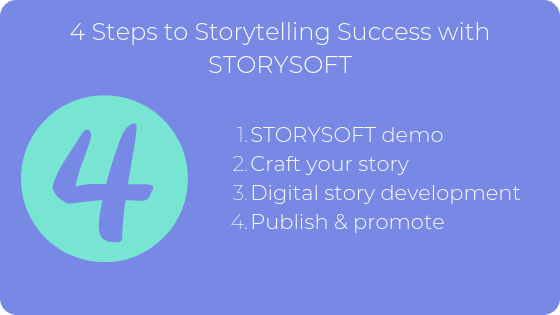
Step 1
Request a demo of the STORYSOFT platform and one of our team members will show you how STORYSOFT works.
Step 2
Choose the type of story to tell and complete the Design Book.
The Design Book provides you with storytelling best practices, story templates, and media specifications in order simplify the story creation process.
Step 3
Work with the STORYSOFT team to develop your story. You provide the story, we take care of bringing your digital story to life.
Step 4
Publish your story on the platform, and share it through any marketing channel.
It's that simple.
CHAPTER 6:
Conclusion
You made it!
Hopefully you found this Brand Storytelling Guide informative.
If you take one thing away from this guide, I hope it's a sense of how powerful storytelling can be for your brand.
I encourage you to dig deeper into the science of storytelling because it will explain why stories are so fundamental to human beings.
We are storytelling creatures.

Tell Your Brand Story
For marketers, it only makes sense to use storytelling to penetrate the human psyche.
Everything we are trying to accomplish, from capturing attention to building emotional bonds with consumers and driving behavior, is what storytelling does best.
Your stories are what makes your brand different from every other brand.
Stories will help you stand out.
Great stories will get people to love your brand, feel for your brand, cry for your brand, and buy your brand.
Every brand has stories.
What's yours?
Learn more about how you can tell breakthrough brand stories using the STORYSOFT digital storytelling platform.
Book a Demo
See how to bring personalized digital experiences to life for your brand
During the call you will:
- Hear how it works
- See example digital Stories
- Walk through the analytics
- Get your questions answered

